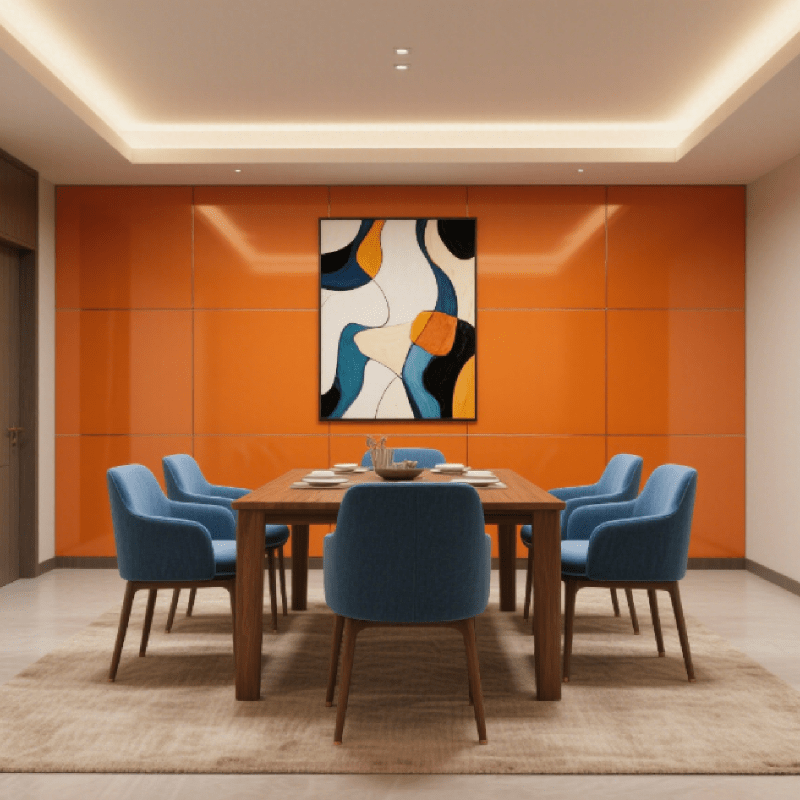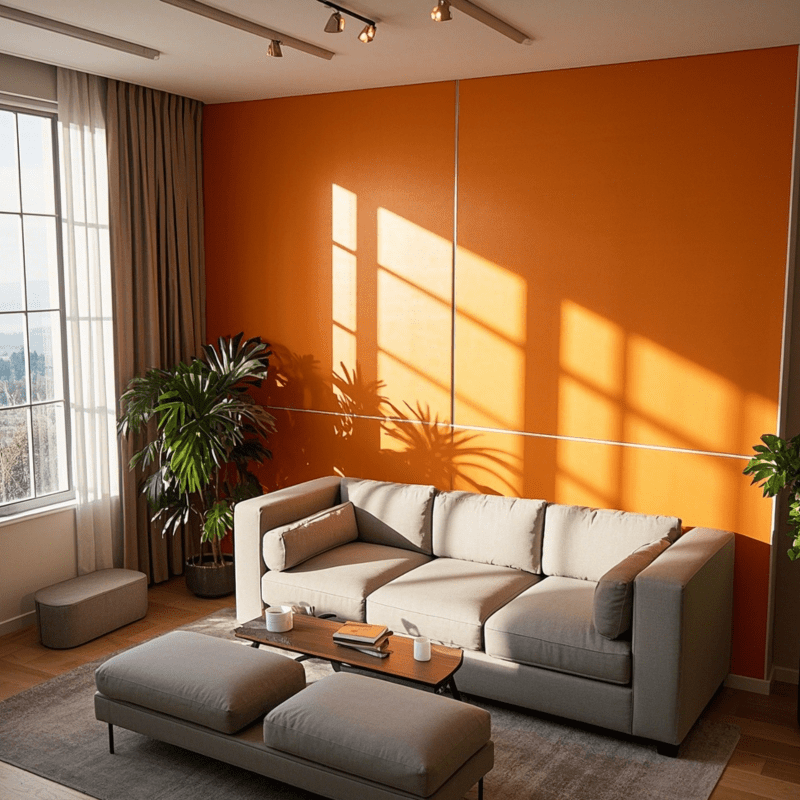Розуміння різних типів стінних панелей для вашого простору
Гіпсокартон: Стандартний вибір для універсальності
Гіпсокартон став найпопулярнішим варіантом для стін, тому що чудово підходить для різних ситуацій. Його встановлюють як у приватних будинках, так і в офісах, адже для монтажу не потрібно особливого досвіду, що пояснює, чому багато людей вирішують зайнятися ремонтом у вихідні самостійно. Матеріал доступний у кількох варіантах товщини, тому будівники можуть обрати той варіант, який найкраще відповідає їхнім потребам — чи то підсилюється несуча стіна, чи додається ще один шар десь у іншому місці. Найбільшою перевагою є простота остаточної обробки. Гладка поверхня гіпсокартону чудово вбирає фарбу, добре тримає шпалери, а також підходить для створення тих стильних текстурованих ефектів, що зараз у моді серед декораторів. Така гнучкість дозволяє вписати його майже в будь-який дизайн інтер'єру, який можна уявити.
Цементна Дошка: Оптимальна для Середовищ з Високою Повлажністю
Проблеми з вологою? Цементні плити можуть бути саме тим, що потрібно будівельникам, адже вони стійкі до утворення плісняви і добре витримують пошкодження водою. Вони чудово підходять для тих складних місць, де вода завжди присутня — стіни ванної кімнати, фартухи на кухні, навіть вологі підлоги в підвалі. Під час укладання плитки на ці поверхні, майстри відзначають, що цементні плити забезпечують міцну основу, яка з часом не деформується і не тріскається. Цікаво, що ці плити добре справляються також з екстремальними температурами. Деякі люди встановлювали їх навіть на вулиці без проблем у спекотне літо і холодну зиму. Для тих, хто планує організувати зовнішній кухонний простір або оновити терасу, цементні плити витримують різноманітні погодні випробування набагато краще, ніж багато альтернатив.
Панелі WPC: Комбінуючи Тривалість та Естетичну Гнучкість
Панелі з деревно-полімерного композиту (WPC) поєднують естетичний вигляд із тривальною міцністю. По суті, вони поєднують зовнішній вигляд натурального дерева з витривалістю пластикових матеріалів, що чудово підходить для сучасних дизайн-проектів. Найкраща частина цих панелей полягає в тому, що вони майже не потребують обслуговування та можуть використовуватися як усередині приміщень, так і зовні — на терасах або в саду, не втрачаючи швидко свій стан. Це означає, що замінювати їх доводиться набагато рідше, ніж традиційні матеріали. Крім того, зараз доступна величезна кількість різних кольорів і поверхневих обробок, що дає дизайнерам багато варіантів для створення інтер'єрів. Незалежно від того, хоче хтось чогось простого чи витонченого, панелі WPC гарно вписуються в більшість стилів оздоблення, що пояснює їхню зростаючу популярність як на ринку дом покращень, так і в умовах великого бізнесу.
Акустичні панелі: Покращення управління звуком
Звукопоглинальні панелі дійсно мають значення в місцях, де важливо контролювати рівень шуму — таких як студії звукозапису, офісні приміщення та навіть домашні кінозали. Вони роблять більше, ніж просто зменшують небажані звуки, адже багато моделей випускаються в різноманітних кольорах і текстурах, які виглядають досить естетично на стінах. Встановлення цих панелей допомагає підприємствам виконувати складні вимоги щодо контролю шуму, яким потрібно відповідати. Найновіші моделі використовують передові матеріали, які чудово зменшують ефекти луна і приглушують постійний фоновий шум. Це суттєво впливає на комфорт людей, які працюють або перебувають у приміщеннях із високим навантаженням, де важливою є чітка комунікація.
Оцінка умов приміщення та екологічних факторів
Визначення рівнів вологоści для розв'язків, що опору є вологі
Правильне вимірювання вологості має велике значення під час вибору вологостійких стінових панелей. Простий гігрометр легко впорається з перевіркою рівня вологості в повітрі, що допомагає визначити, який тип стінових панелей найкраще підходить для місць, схильних до накопичення вологи. Насамперед, це ванна кімната та кухня. Використання неправильних матеріалів у цих зонах часто призводить до різноманітних проблем згодом. Тому варто витратити час на точні вимірювання. Вибір панелей, стійких до вологи, не лише запобігає пошкодженню, а й дозволяє довше зберігати привабливий вигляд у тих складних місцях у будинку, куди волога потрапляє рано чи пізно.
Опції захисту від плісневих грибків для більш здорових просторів
Стінні панелі, стійкі до утворення цвілі, допомагають покращити якість повітря в приміщеннях, тому що містять спеціальні інгредієнти, які перешкоджають росту цвілі. Ці панелі суттєво зменшують небезпеку, пов'язану з плаваючими спорами та алергенами, які викликають різноманітні проблеми зі здоров'ям у людей, що проживають або працюють у таких приміщеннях. Під час вибору звертайте увагу на продукти, які мають сертифікацію Агентства з охорони навколишнього середовища (EPA). Наявність сертифіката EPA означає, що ці матеріали справді витримали суворі випробування на безпеку та ефективність. Власники житла та керівники будівель отримують реальну гарантію того, що їхні стіни не перетворяться на середовище, сприятливе для росту шкідливої цвілі, яка з часом може вплинути на здоров'я усіх мешканців.
Коливання температури та тривалість матеріалів
Дуже важливо знати, як реагують плити на зміни температури, обираючи матеріали для місць, де температура суттєво коливається. Цементні плити показують дуже гарні результати, тому що вони залишаються стабільними навіть при змінах температури, тому імовірність утворення тріщин або деформації плит з часом значно зменшується. Дослідження будівельних лабораторій показують, що вибір правильного типу стінових плит може зменшити витрати на опалення, адже краща теплоізоляція означає менші витрати енергії через стіни. Будівники, які зосереджені як на міцності матеріалів, так і на енергозбереженні, у підсумку приймають більш обґрунтовані довгострокові рішення, які економлять кошти, одночасно забезпечуючи цілісність конструкцій впродовж спекотних літ та холодних зим, які нам добре відомі.
Оцінка товщини стінкових панелей та структурних потреб
Відповідність товщини між пролітами стіб для відповідності нормам
Вибір правильної товщини стінової панелі має велике значення, коли потрібно дотримуватися місцевих будівельних норм і забезпечити структурну міцність стін залежно від відстані між стійками. Тонкі панелі часто добре підходять для місць, де стійки розташовані близько одна до одної, але якщо відстань між ними більша, то краще обрати більш товсту панель для надійної підтримки. Залучення професійного інспектора під час встановлення — це не просто добра практика, це допомагає уникнути проблем у майбутньому. Такі експерти знають, як має виглядати правильна установка згідно з будівельними нормами, що зберігає від зайвих турбот і забезпечує безпеку на довгі роки.
Вдарна сила: Баланс густини та функціональності
Стінні панелі, які витримують удари, мають дуже важливе значення в місцях, де цілий день багато людей пересувається. Під час вибору таких панелей виробникам потрібно знайти правильне співвідношення між їх товщиною та густиною матеріалу. Мета полягає в тому, щоб переконатися, що вони витримують поштовхи, продовжуючи добре виглядати на стінах. Аналіз реальних прикладів також демонструє цікавий факт: будівлі, які обрали правильно протестовані на стійкість до ударів стінні панелі, значно довше зберігають їх експлуатаційні якості, перш ніж знадобиться ремонт або заміна. Це пояснює, чому багато офісних приміщень і шкільних будівель тепер обирають саме такі рішення замість дешевших альтернатив, які можуть швидше зноситися в умовах постійного використання.
Вибір правильного матеріалу для несучих стін
Коли мова йде про несучі стіни, правильний вибір матеріалів має велике значення. Вони мають витримувати вагу будівлі та відповідати вимогам будівельних норм. Кваліфікована думка фахівця допоможе визначити, які саме плити та якої товщини потрібно використовувати для належного несення навантаження. Неправильний вибір матеріалів може призвести до серйозних проблем у майбутньому — структурних пошкоджень і потенційної загрози безпеці. Тому більшість забудовників залучають професіоналів для виконання таких робіт, де помилки просто неприпустимі.
Підбір типів стінних панелей під конкретні застосування
Кухні та ванні кімнати: Водостійкі та плісневостійкі рішення
Кухні та ванні кімнати дійсно потребують стінових панелей, які витримують вологу та стійкі до утворення плісняви, якщо ми хочемо уникнути тих неприємних проблем у майбутньому. У цьому випадку чудово підходять цементні плити, а також спеціальний вид гіпсокартону, призначений для експлуатації у вологих умовах. Люди часто обирають саме ці варіанти, тому що вони виглядають добре й при цьому виконують своє завдання, тож не доводиться жертвувати зовнішнім виглядом на користь захисту від витоків води. Правильний вибір матеріалу допомагає зберігати естетичний вигляд цих приміщень, а також забезпечує міцність стін навіть після багаторічного використання у умовах, коли на них діє пара від душу й бризки води з раковини.

Офісні приміщення: Пріоритет надається акустиці та естетиці
Створення комфортних умов для роботи в офісних приміщеннях справді залежить від досягнення правильної поєднання звукового середовища та естетичного вигляду. Акустичні панелі чудово справляються з цим завданням, адже зменшують неприємне луна, залишаючи естетичний вигляд в офісному середовищі. Деякі компанії також обирають більш бюджетні варіанти, що цілком логічно, якщо прагнути знизити витрати, не жертвуючи надто комфортом. Коли співробітники не відволікаються постійно сторонніми звуками, такими як рух транспорту або розмови сусідів, їхня концентрація значно покращується. Багато компаній помітили, що інвестиції в якісну акустику з часом виправдовуються, не лише задоволеними працівниками, а й реальним підвищенням продуктивності. Офіси, які досягають цього балансу, стають місцями, де люди хочуть проводити робочий час, а не шкодувати про кожну хвилину.
Гаражі та утилітарні області: опції з захистом від вогню та впливовою стійкістю
Стінові панелі, встановлені в гаражах і допоміжних приміщеннях, мають відповідати вимогам пожежної безпеки та витримувати удари, якщо ми хочемо досягти максимальної безпеки та тривалої експлуатації. Вибір продуктів, які відповідають галузевим стандартам, значно зменшує ризик виникнення пожежі, а також забезпечує міцність конструкцій — особливо важливо для цих зон з інтенсивним рухом. Завжди перевіряйте, що місцеві будівельні норми вимагають щодо протипожежного захисту, перш ніж обирати матеріали для таких приміщень. Вигода від правильного вибору виходить за межі лише поліпшення безпеки. Правильно підібрані стінові панелі роблять ці робочі зони більш функціональними, витримуючи щоденне зношування без руйнування через кілька місяців.
Вогневі рейтинги та стандарти безпеки для стінних панелей
Розуміння UL вогневих рейтингів для зон високого ризику
Вогнестійкість за класифікацією UL відіграє ключову роль під час оцінки безпеки стінових плит для зон, схильних до виникнення пожеж, таких як кухні та машинні відділення, де часто трапляються іскри та джерела тепла. Ці класифікації дають будівельникам змогу зрозуміти, наскільки добре ті чи інші матеріали витримують полум'я, що допомагає їм приймати кращі рішення для їхніх проектів. Аналіз різних класифікацій UL дозволяє фахівцям обирати матеріали, які дійсно ефективно протистоять загрозі пожежі. Дослідження показують, що будівлі, зведені з використанням матеріалів, схвалених UL, зазвичай зазнають меншого збитку під час виникнення пожеж. Саме тому правильний підхід до врахування класифікації UL залишається важливим для захисту житла та бізнесу від втрат, пов'язаних з пожежами.
Відповідність місцевим будівним нормам
Підбираючи стінові панелі для проекту, має значення, чи вони відповідають місцевим будівельним нормам, адже правила змінюються в залежності від регіону та впливають на те, які матеріали можна офіційно використовувати. Підрядникам та власникам нерухомості потрібно стежити за оновленнями норм, щоб їхня робота пройшла перевірку безпеки та уникнути проблем з владою згодом. Дотримання цих правил робить будівлі безпечнішими загалом, а також спрощує отримання дозволів на нове будівництво чи реконструкцію. Найчастіше доведеться подавати документи та проходити фактичні перевірки на дотримання протипожежних вимог. Ці норми відіграють важливу роль у забезпеченні безпеки будівель для всіх зацікавлених сторін.
Найкращі матеріали для коридорів виходу та зон з високим ризиком вогню
Вибір матеріалів для евакуаційних коридорів та зон, схильних до виникнення пожеж, відіграє ключову роль у забезпеченні безпечних шляхів евакуації. Матеріали, стійкі до вогню, допомагають уповільнити поширення полум'я й диму, що зменшує ризик у разі надзвичайних ситуацій. Під час проектування таких просторів консультація з кваліфікованими фахівцями з питань пожежної безпеки дозволяє отримати практичні рекомендації щодо найкращих рішень у конкретних ситуаціях. Встановлення вогнестійких стінових панелей безумовно підвищує рівень безпеки в таких ключових зонах, хоча перед цим важливо перевірити чинні місцеві будівельні норми та вимоги. Більшість будівель уже мають певний рівень захисту, але використання більш якісних матеріалів дозволяє відповідати вищим стандартам безпеки та забезпечити додаткове відчуття захищеності для мешканців.
Поради щодо установки для бездоганних, професійних результатів
Листи з усіченими краями для невидимих швів
Закінчені краї аркушів суттєво впливають на те, як виглядатимуть шви та стики після встановлення стінових панелей. Якщо виконати все належним чином, стіни виявляться достатньо гладкими для фарбування або текстурування, без вадних зазорів, що проступають крізь них. Майстри, які витрачають час на правильне виконання цього етапу, досягають кращих результатів, ніж при грубому та неякісному монтажі. Вигода? Чистіше фінішне покриття, яке не потребуватиме постійного дотикування згодом. Крім того, роботи завершуються швидше, адже менше часу витрачається на виправлення поганих стиків. У кінцевому підсумку виграють усі — як з естетичної точки зору, так і з точки зору дотримання графіка проекту.
Техніки суставного компоненту для завершень рівня 5
Правильне виконання оздоблення на рівні 5 залежить від якісної роботи зі шпаклювання, особливо якщо згодом планується нанесення фарби з високим глянцем. Увесь процес фактично зводиться до правильного нанесення та шліфування шпаклівки. Більшість людей помічають, що додатковий час, витрачений на цей етап, суттєво впливає на те, наскільки гладкими і професійними будуть стіни у фінальному результаті. Звісно, це вимагає деякого часу, щоб звикнути, і чимало спроб, перш ніж все почне виглядати чудово, але повірте, додаткові години роботи справді варті фінального результату.
Необхідні інструменти для ефективного монтажу
Правильні інструменти мають ключове значення під час встановлення стінових панелей. Добрий набір включає такі речі, як шпаклівальний ніж для вирівнювання швів, надійна електродриль з різноманітними свердлами та хоча б один якісний рівень, щоб усе було прямим. Якщо людина витрачає гроші на обладнання достойної якості замість дешевих аналогів, вона помітить, наскільки швидше виконуються роботи та наскільки кращим буде кінцевий результат. Перш ніж починати будь-який проект, варто заздалегідь усе організувати. Розкладіть інструменти так, щоб вони були під рукою, акуратно складіть панелі у зручне місце, а можливо, навіть позначте, де має бути кожна частина. Така підготовка зменшує фрустрацію під час роботи та забезпечує безперервне виконання всього процесу встановлення без зайвих зупинок і початків.
Економічна ефективність: мінімізація витрат та праці
Обчислення розмірів панелей для зменшення відходів
Правильне визначення розмірів дощок під час вимірювання площі приміщення допомагає зменшити кількість відходів під час монтажних робіт. Точні вимірювання означають менше зайвих шматків, які залишаються після виконання роботи, що дозволяє заощадити кошти на матеріалах, а також на вивезенні та утилізації зайвого дерев'яного сміття. Програми для проектування полегшують визначення точних розмірів матеріалів, необхідних для різних частин простору. Такий уважний підхід до початку будь-якого проекту має кілька переваг водночас. Він запобігає марнотратству ресурсів і є економічно вигідним, адже ніхто не хоче платити зайвого за те, що не є необхідним з самого початку.
Розглядання покупок у великому обсязі та зберігання
Коли хтось купує стінні панелі великими партіями, зазвичай він платить менше за кожну одиницю та не залишається без них у середині проекту. Але є ще один важливий момент, про який нині ніхто не згадує: необхідно знайти добре місце для зберігання, щоб панелі не викривилися або не пошкодилися, поки чекають на встановлення. Правильне зберігання насправді відіграє ключову роль у збереженні придатності панелей протягом кількох місяців, інакше їх доведеться викинути, бо вони втратять форму. І, насправді, планування покупок заздалегідь допомагає уникнути зайвого клопоту в майбутньому. Підрядники, які заздалегідь розраховують потребу в матеріалах, можуть ефективніше витрачати кошти, отримуючи при цьому продукцію належної якості для будинків своїх клієнтів.
Стратегії економії праці для любителів самостійного ремонту та підрядників
Економія часу на робочі процеси робить проекти більш ефективними для всіх — від домашніх майстрів до професійних підрядників, які працюють над великими об'єктами. Наприклад, заздалегідь виготовлені деталі значно прискорюють роботу, забезпечуючи при цьому послідовність у зовнішньому вигляді після складання. Коли робітники отримують належне навчання правильній установці елементів, вони виконують завдання швидше, оскільки розуміють, що роблять, а не намагаються впоратися методом проб і помилок. Програмні додатки та інші технологічні пристрої допомагають усім учасникам процесу бути в курсі того, що має бути зроблено наступним, що призводить до меншої кількості затримок і кращих загальних результатів. Усі ці підходи разом скорочують витрати на робочу силу, прискорюючи виконання проектів без втрати якості.
Розділ запитань та відповідей
Які найкращі стінкові плити для областей з високою повологостю?
Цементні плити та водостійка гіпсокартонна плита ідеальні для районів з високою повологостю, таких як ванні кімнати та кухні, надаючи тривалість та захист від шкоди через воду.
Як вибрати правильну стінкову плиту для керування звуком?
Для ефективного керування звуком рекомендується використовувати акустичні панелі, оскільки вони допомагають зменшити шум та покращити якість звуку в приміщеннях, таких як студії та офіси.
Чи існують стінкові панелі, спеціально розроблені для безпеки від вогню?
Так, існують панелі зі зниженням ризику вогню, які придатні для місць, схильних до вогневих загроз, таких як гаражі та утилітарні кімнати, що допомагає зменшити небезпеку вогню та покращити безпеку.
Як можна мінімізувати викиди під час монтажу стінкових панелей?
Точне вимірювання та планування за допомогою програмного забезпечення для дизайну може зменшити викиди, тоді як закупівля великою партією та правильне зберігання допоможуть ефективно керувати ресурсами.
Чому використовуються листи з похилими краями під час монтажу?
Листи з похилими краями роблять шви та з'єднання менш відомими, забезпечуючи професійний та гладкий вигляд поверхні стіни.
Які інструменти є необхідними для монтажу стінкових панелей?
Необхідні інструменти для монтажу стінкових панелей включають шпателі для стрічок, електродрільні машини та квадратні рівні, щоб забезпечити потужний та професійний процес.
Зміст
- Розуміння різних типів стінних панелей для вашого простору
- Оцінка умов приміщення та екологічних факторів
- Оцінка товщини стінкових панелей та структурних потреб
- Підбір типів стінних панелей під конкретні застосування
- Вогневі рейтинги та стандарти безпеки для стінних панелей
- Поради щодо установки для бездоганних, професійних результатів
- Економічна ефективність: мінімізація витрат та праці
-
Розділ запитань та відповідей
- Які найкращі стінкові плити для областей з високою повологостю?
- Як вибрати правильну стінкову плиту для керування звуком?
- Чи існують стінкові панелі, спеціально розроблені для безпеки від вогню?
- Як можна мінімізувати викиди під час монтажу стінкових панелей?
- Чому використовуються листи з похилими краями під час монтажу?
- Які інструменти є необхідними для монтажу стінкових панелей?

